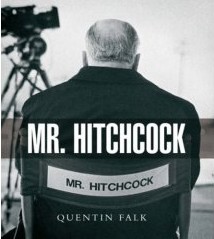
'Mr. Hitchcock' By Quentin Falk , London: Haus Publishing,
2007. ISBN 978 1 904950 75 2 200pp. (hardback) £20.00
Mr. Hitchcock is, like the director’s work itself, very much a
mixed bag. The title of Quentin Falk’s book suggests a respect that the
book does not always hold- consider the frequent references to
Hitchcock’s ‘egg-shaped physique’ (p.16), that he was ‘increasingly
rotund’ (p.23) and the inclusion of a Michael Powell quote that
Hitchcock ‘really was the fattest young man I had ever seen’ (p.37).
That these three comments occur in the first quarter of Falk’s book
suggest an uneasy balance of biographical musings and over-familiar
friviolity.
The book starts its exploration of Hitchcock’s life and career with a
focus on Frenzy (1972), almost the director’s swan-song. That
Falk feels the film to be ‘problematic’ and ‘strange, often
uncomfortable [in] nature’ (p.15) seem odd comments given the amount of
time spent on analysing it (compare this with the few lines afforded
other works worthy of extended comment like Sabotage(1936).
True, the piece on Frenzy is used as a summation of Hitchcock
until that moment in time- a man now in his early seventies looking
back on an illustrious career- but Falk underestimates the sheer force
and power of this, Hitchcock’s last great film. As for the
‘uncomfortable’ aura of Frenzy - are Hitchcock films intended
to be about making us feel wholly comfortable? Surely the opposite!
However, Falk’s feelings about Frenzy aside, the book needs to
begin somewhere before tracing the director’s formative years and his
meteoric rise.
As Mr. Hitchcock progresses through its subject’s life and
career the previously-cited uneasy balance (inferred from the title
contrasted with the treatment of the man inside its pages) becomes
sadly more apparent. Although ‘plain’ biographical details are present,
amusing anecdotes are used to help us understand Hitchcock’s ways of
working. These are often connected with films to which an uneven
balance of attention is subsequently drawn. Therefore, some are
discussed at length- including the cardinal sin of recounting plot
details even down to outlining the resolution of the closing sequence
(of which Hitchcock would certainly not have approved!)- others
summarily dismissed in a few sentences or even words, such as The
Farmer’s Wife and The Manxman. Given the plethora of
available
material on the director, and the much-lauded ‘interviews with
Hitchcock’s most valued collaborators’ (p.2), a detailed plot
description of a film like The 39 Steps is not actually
necessary, but an insight into how Hitchcock developed his cinematic
style in his early silent films is.
Despite its winning formula (that its subject was not only
idiosyncratic but highly interesting in his own right) Mr.
Hitchcock incorporates a most odd, uneven style. In the way that
Hitchcock’s stylish direction is subtle yet obvious, Falk’s narration
of Hitchcock’s story is obvious yet clumsy. Just one example of this
occurs on page 50- ‘C.M. Woolf, who clearly believed the company’s
hottest property to be far too clever for his good would, if Michael
Balcon hadn’t swiftly intervened, have happily terminated Hitchcock’s
contract.’ This is typical of the writing throughout, which tends to be
either overly detailed or brief to the point of foolishness- ' Young
and Innocent(1937)…is essentially forgettable'. (p.53). Actually,
as in the case of Frenzy, this author begs to differ-
Young and Innocent is a delightfully unpretentious film that is
both a fascinating evocation of pre-war Britain and a splendid
forerunner of later Hitchcock films.
A typical Hitchcock film uses carefully constructed set-pieces to set
an increasing pace prior to the crescendo of tension which often marks
the film’s closing sequence. Mr. Hitchcock on the other hand
stumbles doggedly along a slightly uncertain path, arriving at its
destination tired and in need of a drink followed by a good lie-down as
a result. Although, like Hitchcock, it has a good tale to tell, the
book does not imbue its tale with any cinematic aplomb, preferring to
plod along uneasily on the back of a handful of anecdotes and a
reliance on existing interview material (the landmark conversation
Hitchcock had with French director Francois Truffaut is frequently
utilised). There are some lovely monochrome illustrations however, the
evocative publicity pictures more than compensating for the bland
choice of stills from the films themselves. These pictures are
complimented by some nice candid pictures of Hitchcock himself to
brighten up a sometimes rather jerky narrative.
In the modern age of the high-speed Super Highway, information is more
readily accessible than ever. Putting the two words ‘Alfred Hitchcock’
into search engine Google yields over 9.5 million matches. It would be
safe to say that there is no shortage of material written on ‘the
Master of Suspense’. Though this would seem a positive development, it
is perhaps an adverse one for any writer attempting to find a new
angle, a new slant, on a director whose career lasted over 50 years and
began in silent films but came to embrace not only sound but colour and
widescreen technologies. Put simply- any new work on Hitchcock, for me,
needs to say something new. It is not enough to recycle the Sunday
roast of existing material as Monday’s literary stew. What the film
world needs is a fresh piece of cinematic meat, thoroughly cooked and
served fresh with a frisson. What Falk’s book, for all its
gloss and sheen, serves up is a reheated melange. Hitchcock,
one feels sure, deserves better than that.
'Mr. Hitchcock' is published by Haus Publishing.
Haus Publishing website
Back
Home

